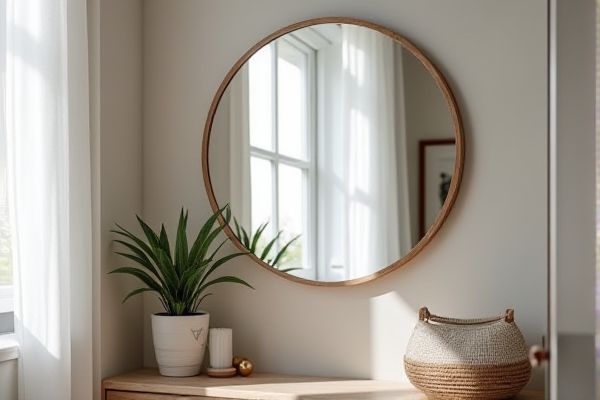
A smart mirror integrates technology to display information like weather, news, and calendar events while reflecting your image, enhancing convenience beyond a regular mirror's basic function. Discover how your daily routine can be transformed by understanding the key differences between smart mirrors and traditional mirrors in the rest of this article.
Table of Comparison
| Feature | Smart Mirror | Regular Mirror |
|---|---|---|
| Functionality | Displays weather, news, time, notifications | Reflects image only |
| Technology | Built-in display, IoT-enabled, touchscreen (optional) | Standard glass with reflective coating |
| Connectivity | Wi-Fi, Bluetooth support | None |
| Interactivity | Interactive interface, voice control (in some models) | None |
| Price | High (varies from $200 to $2000+) | Low (average $10 to $100) |
| Usage | Smart homes, fitness, retail, professional grooming | Everyday personal use |
| Power Source | Requires electrical power | No power needed |
Introduction to Smart Mirrors and Regular Mirrors
Smart mirrors integrate advanced technology such as touchscreens, voice recognition, and augmented reality to offer interactive features like personalized displays, weather updates, and virtual try-ons. Regular mirrors provide a simple reflective surface used primarily for personal grooming and decor without any digital enhancements. The evolution from traditional reflective glass to smart mirrors represents a significant shift in user experience, blending functionality with innovation.
Key Features of Smart Mirrors
Smart mirrors integrate digital displays with traditional reflective surfaces, offering features like touch-screen controls, voice activation, and real-time information such as weather updates, calendar events, and news feeds. Many smart mirrors include augmented reality capabilities for virtual try-ons, fitness tracking, and personalized skincare analysis through embedded sensors. Unlike regular mirrors, smart mirrors enhance daily routines by providing interactive and connected experiences that go beyond simple reflection.
Traditional Mirror Functionality
A traditional mirror primarily serves the purpose of reflecting your image with clear, undistorted visibility using a polished glass surface coated with a reflective metal layer, typically silver or aluminum. This simple optical device offers no interactive features or digital enhancements, making it purely utilitarian for personal grooming and spatial awareness. While effective for basic reflection, it lacks the smart technology integration found in modern smart mirrors.
Design and Aesthetic Differences
Smart mirrors feature sleek, modern designs with integrated LED displays and touchscreens that offer customizable information overlays, blending technology seamlessly into bathroom or bedroom aesthetics. Regular mirrors emphasize simplicity and classic aesthetics, typically framed or frameless with reflective glass that caters to traditional interior decor. The minimalist design of regular mirrors contrasts with the multifunctional and tech-savvy appeal of smart mirrors, making the latter a statement piece in contemporary smart homes.
Smart Mirrors: Technology Integration
Smart mirrors integrate advanced technologies such as touchscreens, voice recognition, and augmented reality to provide interactive experiences beyond reflection. They offer features like personalized health tracking, virtual try-ons, and real-time information display, enhancing daily routines. Unlike regular mirrors, smart mirrors connect to the internet and smart home devices, enabling seamless digital interaction and customization.
Installation and Maintenance Comparison
Smart mirrors require professional installation due to their integrated electronic components, often involving electrical wiring and mounting specific to their technology. Regular mirrors offer straightforward, DIY-friendly installation with minimal tools and no electrical setup, making them easier and quicker to mount. Maintenance for smart mirrors includes software updates and occasional electronic repairs, while regular mirrors need only basic cleaning and occasional re-mounting adjustments.
Cost Analysis: Smart vs. Regular Mirrors
Smart mirrors typically cost between $200 and $1,500 depending on features like touchscreens and integrated displays, while regular mirrors range from $20 to $200 based on size and frame quality. The higher initial investment in a smart mirror is balanced by added functions such as digital assistants, weather updates, and fitness tracking, which may reduce the need for multiple devices in your space. Choosing the right option depends on whether you value advanced technology and convenience or prefer a budget-friendly, traditional reflective surface.
User Experience and Convenience
Smart mirrors enhance user experience by integrating touch controls, voice commands, and personalized information displays such as weather updates, calendar events, and fitness tracking directly on the mirror surface. Unlike regular mirrors, they offer convenience by allowing you to perform multiple tasks simultaneously, transforming your daily routine into a seamless, interactive experience. This technology reduces the need for additional devices, making grooming and planning more efficient and engaging.
Energy Efficiency and Sustainability
Smart mirrors enhance energy efficiency by using LED lighting and sensors that activate only when needed, reducing electricity consumption compared to regular mirrors with constant lighting. Their integration with energy-saving technologies supports sustainability by minimizing waste and promoting longer product lifespans. Choosing a smart mirror helps you contribute to eco-friendly practices through reduced energy use and smarter resource management.
Choosing the Right Mirror for Your Needs
Smart mirrors offer interactive features like touchscreens, voice control, and integrated apps that enhance daily routines, while regular mirrors provide a simple, clear reflection without added technology. Your choice depends on whether you prioritize connectivity and multifunctionality or straightforward practicality and affordability. Consider how the smart mirror's advanced capabilities align with your lifestyle and whether the investment matches your needs.
 homyna.com
homyna.com